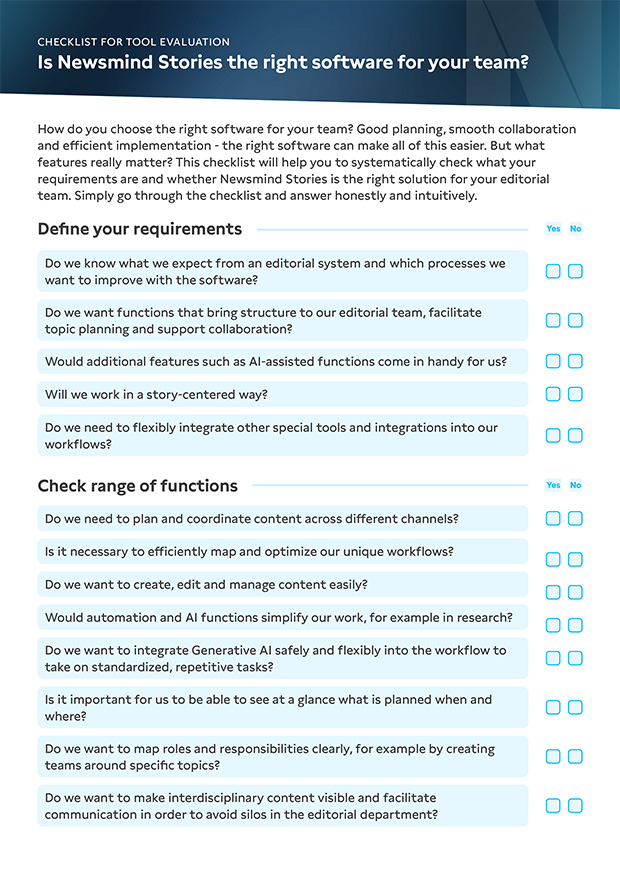The editorial planning is one of the most important tools for newsroom employees and content teams. After all, wherever content is involved, it needs to be sorted and clearly distributed across various communication channels. This is just as true for traditional newsrooms as it is for companies and other publishers. While journalistic newsrooms tend to be confronted with too many topics, corporate newsrooms may find that topics are in short supply. It is therefore essential to create an editorial plan in which editors can organise their topic planning according to their needs, i.e. which topics they would like to work on and publish in the coming days, weeks and months. Needless to say, editors can use standard tools such as Excel. However, this approach reaches its limits. Especially when editorial planning also needs to automatically take information from various digital sources into account. The solution: a tool for editorial planning.
Content of this page
What is editorial planning?
Editorial planning is the strategic core of all successful content and communication work. It translates goals and ideas into a concrete plan – with clear topics, responsibilities and timings. This allows teams to maintain an overview, avoid duplication of work and publish regularly instead of ad hoc. Good planning creates transparency, uncovers gaps and ensures that content is created in a targeted and efficient manner. It is therefore not something that can be quickly pulled out of thin air. Every media company has different requirements, depending on publication frequency, team size and content focus. Editors-in-chief should therefore clarify a number of strategic questions with their team in advance:
Target group: Who do I want to address?
In the corporate newsroom in particular, but also in a journalistic environment, employees are well advised to know their target group precisely. What are they interested in? What are their pain points? What challenges are they struggling with? What goals are they pursuing?
Objectives: What do I want to achieve?
In most cases, the target groups also provide an objective that an editorial team wants to achieve with its content: from informing, educating and entertaining consumers to attracting the attention of the target group, generating new leads and winning them as new customers.
Channel: Which touchpoints do I use to reach my target group?
To achieve this, content teams must ensure that the content is available where the target group is. It is important to adapt the content to the needs of the target audience and in accordance with channel-specific conventions. How articles, video or audio contributions appear on the website or in print usually differs from one another and also from social media or other channels. This must be taken into account during editorial planning.
Format: What is the best way to prepare my content?
Depending on the target group and channel, a topic can be presented in completely different ways. Texts are ideal for the blog, while YouTube naturally requires videos. For Instagram, on the other hand, high-quality photos and graphics as well as short videos in portrait format are a must. It is therefore essential to familiarize yourself with the formats of the respective channel.
Ideas: What do I want to communicate?
In practice, it has proven to be a good idea to create a topic-centered editorial plan. The basis is initially a topic planning independent of channels, which then fills the editorial plan. This makes it easier to play topics across channels and formats. This saves time and improves coordination within the team.
What is an editorial plan?
An editorial plan is the central control element for editorial teams. It bundles all relevant information for content publication and helps to structure and schedule publications. Whether in the newsroom or in content marketing – a well thought-out editorial plan ensures an overview and efficient processes.
It contains not only topics and publication dates, but also responsibilities and important work steps. Depending on the frequency of publication – often dozens or hundreds of articles per day in journalistic editorial offices – the planning grows quickly. This makes it all the more important to clearly define processes and make them practicable.
Many editorial teams plan several months in advance. This is why the term “editorial calendar” has become established. Fixed topics and series form the basic framework, while flexible slots leave room for current events. This keeps reporting up-to-date and responsive.
Planning also includes unforeseen events. Good editorial planning can be adapted and integrates recurring events such as public holidays or industry events. This makes it possible to target these occasions with suitable content.
In short: an editorial plan is more than just a list. It is the strategic tool that media companies need to work in a structured, flexible and targeted manner. But above all, there is no one right way to create an editorial plan.
Creating an editorial plan - what are the different approaches?
There are different approaches to creating an editorial plan, which differ in terms of their complexity. And while a good editorial plan provides structure in any form, without the right tool, implementation can quickly become confusing. It is therefore worth taking a closer look at the various approaches to editorial planning and the appropriate tools.
Paper-based editorial planning
Especially when employees in editorial teams or a corporate newsroom are faced with the challenge of creating their first editorial plan, getting together in a small group for a brainstorming session can be useful. And yes, pen and paper are still very much welcome here for recording initial ideas as part of a kick-off or workshop. Ideally, an interdisciplinary team should use a flipchart on which they attach post-its with ideas and cluster them as required. The results of analogue topic planning are usually quite good, although there is inevitably a media break. Eventually, the ideas have to be transferred to a digital editorial plan.
Tip: Instead of real post-its, start a simple digital planning process with boards and lists, for example in Trello. Teams can also organize topics and brainstorming digitally.
Create an editorial calendar with Excel & Co.
A simple solution for editorial teams that do not want a large software overhead remains the classic editorial calendar with Excel spreadsheets or Google Sheets. If these are accessible as an editorial plan via the browser for all authorized users, several employees can work with the plan in parallel and the editorial planning remains flexible to a certain extent. Excel can provide a clear structure, but becomes inflexible if the complexity increases.
Use a content management system for editorial planning
In addition, some content management systems (CMS) support the creation of to-do lists. Admittedly, such a list does not replace professional topic planning. Nevertheless, it can be very helpful for assigning work and proofreading tasks to a person, for example, and for ticking off tasks once they have been completed. Depending on the CMS, it is also possible to save smaller input texts directly.
Editorial planning with a professional editorial planning tool
Many editorial offices combine the methods mentioned, wanting to plan for the long term but also wanting to leave room for spontaneous content. In order to be able to work with all events, volumes of information and the number of information sources – from established sources such as news agencies, research networks, press spokespersons, event portals and authorities to the personal contacts and research of their own editors and social media posts – modern editorial offices rely on software for their topic and editorial planning. The right software helps to keep an eye on topics and deadlines, assign responsibilities and manage content efficiently. It is important that the tool can be seamlessly integrated into the daily work routine and reduces the workload. Editorial systems with integrated AI are particularly good at taking work off your hands. An AI-based editorial planning tool such as Newsmind Stories, for example, not only monitors countless digital sources and streams. It also pre-sorts the incoming reports, summarizes them in topic clusters and finds topics and trends on the fly.
Is Newsmind Stories the right software for your team?
Our checklist will help you to check what your requirements are and whether Newsmind Stories is the right solution for your team.

What information belongs in an editorial calendar?
A variety of aspects need to be taken into account when planning editorial work – from ideas and events to tasks and deadlines to responsibilities and accountabilities. The following applies: Good planning is half the battle. Ideally, the editorial plan should be so well developed that one look at it is enough to know which topics are to be published in three or five months’ time. It is therefore advisable to take the following information into account when content teams create an editorial plan:
How does an editorial planning tool support topic planning?
A web-based tool for editorial planning is an extremely useful tool, especially for editorial offices and newsrooms that obtain their input from a variety of sources – including digital ones. After all, it takes editorial teams a lot of time to filter out the information and sources relevant to the respective medium and its target group from the wealth of available information and sources and to keep track of all topics and stories so as not to get bogged down in version chaos or duplicate work. It is obvious that this task can no longer be accomplished manually on post-its or in simple lists. Instead, an editorial planning tool reduces last-minute stress, improves internal coordination and strengthens the editorial line. Those who plan strategically work more efficiently – and at the same time create more space for creative ideas.
Anyone looking for even more support now relies on AI-supported systems. This is because even conventional editorial planning tools quickly reach their limits when dealing with millions of individual pieces of information from dozens of sources. How can an editorial planning tool based on artificial intelligence provide relief here? The Newsmind Stories software, for example, automates many otherwise very repetitive and time-consuming tasks, for example in research and monitoring. It also helps to pre-sort stories according to relevance and display similar stories from the competition. Generative AI also supports the creation of posts or articles.
By the way: You can find out more about AI in journalism and what use cases might look like in our Infothek.
Our editorial planning software in action
Under the name Plan.R, WDR uses our AI-based Newsmind Stories software to plan topics efficiently and across channels – i.e. for television, radio and social media.
Editorial planning – our conclusion
Newsrooms of all sizes cannot avoid professional editorial planning. The more complex and extensive the requirements in terms of topic planning and editorial planning are, the more indispensable an editorial calendar is. In the hustle and bustle of day-to-day operations, it serves as a support so as not to lose the common thread in content collection, structuring, scheduling, preparation and distribution. In addition, professional editorial planning is needed to optimise the distribution of individual to-dos among the available resources. For all content-specific tasks, an editorial planning tool demonstrates its strength and increases the efficiency of newsrooms on a daily basis.
More interesting articles that you shouldn’t miss





